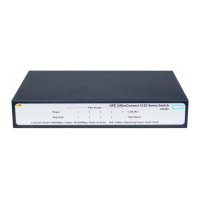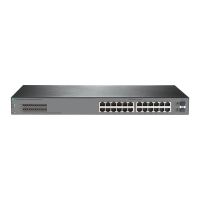134
If this command is configured on a member port in an aggregation group, is takes effect only after the
port leaves the aggregation group.
If you do not specify an MSTI or VLAN, this command sets the path cost of a port in the MSTP CIST
or in the STP or RSTP spanning tree.
Examples
# In MSTP mode, set the path cost to 200 for GigabitEthernet 1/0/1 in MSTI 2.
<Sysname> system-view
[Sysname] interface gigabitethernet 1/0/1
[Sysname-GigabitEthernet1/0/1] stp instance 2 cost 200
# In PVST mode, set the path cost to 200 for GigabitEthernet 1/0/1 in VLAN 2.
<Sysname> system-view
[Sysname] interface gigabitethernet 1/0/1
[Sysname-GigabitEthernet1/0/1] stp vlan 2 cost 200
Related commands
display stp
stp pathcost-standard
stp dispute-protection
Use stp dispute-protection to enable dispute guard.
Use
undo stp dispute-protection to disable dispute guard.
Syntax
stp dispute-protection
undo stp dispute-protection
Default
Dispute guard is enabled.
Views
System view
Predefined user roles
network-admin
Usage guidelines
Dispute guard blocks a port to prevent loops when an unidirectional link is detected on the port by the
spanning tree feature.
In some VLAN networks, an uplink port on a downstream device is configured to deny packets from
the PVID. As a result, the downstream device cannot receive BPDUs of the PVID from the upstream
device. However, the upstream device can receive BPDUs from the downstream device. In this case,
dispute guard blocks the receiving port on the upstream device, which causes traffic interruption.
To ensure service continuity and prevent the link from being blocked, you can disable dispute guard
by using the
undo stp dispute-protection command.
Examples
# Disable dispute guard.
<Sysname> system-view
[Sysname] undo stp dispute-protection

